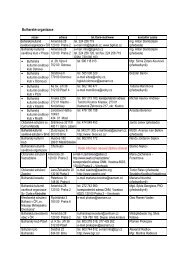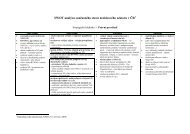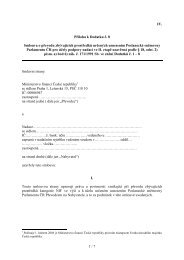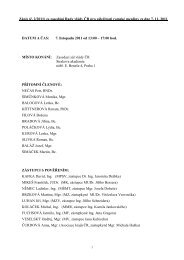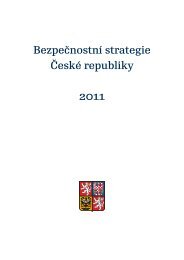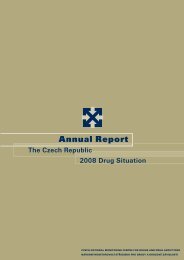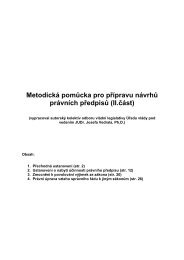The Czech Republic Annual Report 2010 Drug ... - Drogy-info.cz
The Czech Republic Annual Report 2010 Drug ... - Drogy-info.cz
The Czech Republic Annual Report 2010 Drug ... - Drogy-info.cz
Create successful ePaper yourself
Turn your PDF publications into a flip-book with our unique Google optimized e-Paper software.
<strong>Republic</strong> for the Period 2011–2012 foresees that the level of the drug policy measures achieved will be stabilised<br />
and their quality maintained.<br />
11.2.2 Cooperation with Non-Governmental Organisations<br />
NGOs make up the largest group of external providers of drug services in prisons; they operate in 32 of the 36<br />
prisons. <strong>The</strong>re are 15 NGOs involved, six of which provide their services in an intensive form; for details see the<br />
regular chapter on Responses to <strong>Drug</strong>-related Health Issues in Prisons (p. 128). One of the tasks arising for the<br />
Prison Service from the <strong>2010</strong>–2012 Action Plan is to develop a methodology for the provision of drug services in<br />
prison by external providers. <strong>The</strong> Prison Service is working with the representatives of the A.N.O. Section for <strong>Drug</strong><br />
Services in Prison to develop this methodology.<br />
11.3 Provision of <strong>Drug</strong>-Related Health Services in Prison<br />
Whether or not a prisoner is a drug user is identified immediately upon the commencement of their prison term or<br />
remand period during the initial medical examination, the procedure for which is defined by Order of the Minister of<br />
Justice No. 4/2008 regarding the provision of healthcare to persons on remand or serving their prison sentence,<br />
which specifies that, among other data, <strong>info</strong>rmation about smoking and other habits, in particular alcohol or drug<br />
addiction, should be determined as part of the person’s medical history. Screening tests are also performed to<br />
identify any infectious diseases. Physical somatic examinations then focus on determining any external marks of<br />
drug use (needle marks, phlegmona, or phlebitis). This <strong>info</strong>rmation becomes a part of the medical records, which are<br />
available to the healthcare staff and to a clearly defined circle of persons but not to the expert staff members working<br />
at the prison wing (psychologist, therapist, special education professional, social worker, educator) who provide or<br />
participate in drug-related interventions. Information about drug use by the prisoner is therefore identified again, after<br />
the initial medical examination is performed, by such professionals through interviews, on the basis of which a<br />
comprehensive report on the offender is prepared 122 . <strong>The</strong> interviews are conducted separately by a psychologist, a<br />
social worker, and a special education professional. Repeated queries by various professionals may help verify the<br />
credibility of the <strong>info</strong>rmation obtained from the prisoner. A prisoner management programme (sentence plan) is<br />
prepared on the basis of the comprehensive report; this programme includes its objective(s) and the set of<br />
corresponding activities, the performance of which becomes the obligation of the offender. <strong>The</strong> <strong>info</strong>rmation that the<br />
prisoners provide about their drug use is used in the area of reducing the demand for drugs, as well as reducing their<br />
supply. <strong>The</strong> Prison Service is responsible for observing all the statutory conditions applicable to serving a prison<br />
sentence or remand period. It therefore uses the available legal means to enforce the prohibited production,<br />
possession, and consumption of alcohol and other drugs by offenders.<br />
<strong>The</strong> records regarding imprisoned drug users are maintained by the healthcare centre of the relevant prison for the<br />
purposes of providing healthcare. Other <strong>info</strong>rmation about the clients using the drug services is collected centrally at<br />
the level of the General Directorate of the Prison Service but each professional centre keeps its own records. 123<br />
Each intervention (both individual and group) provided to a prisoner is entered in the personal records but a general<br />
and centralised overview of the interventions provided in the individual professional centres is still lacking. <strong>The</strong> Prison<br />
Service is currently addressing the issue seriously – an instrument is being developed for the keeping of centralised<br />
records of the activities and other facts regarding the implementation of the drug policy. However important the<br />
various combined statistics are, it is necessary to ensure that the staff delivering the drug-related services in prison<br />
are not overloaded with excessive record-keeping tasks and that the records are not kept at the expense of the<br />
provision of such services to the offenders.<br />
11.3.1 Services Provided to <strong>Drug</strong> Users in Prisons<br />
As a standard, the comprehensive report is used to give each prisoner a choice from the options offered by the<br />
prisoner management programme. <strong>The</strong> activities of the management programme are divided into work, educational,<br />
special educational, and leisure activities. <strong>The</strong> prisoner can therefore choose to participate in various regular<br />
activities aimed at drug-related prevention, among other factors. <strong>The</strong>se activities are most typically conducted in<br />
groups but the individual form is also common. <strong>The</strong> drug prevention counselling centre is usually in charge of<br />
providing the prisoners with <strong>info</strong>rmation about the individual drug-related activities in the prison concerned.<br />
Services for drug users are predominantly provided through dedicated professional centres, which include<br />
specialised wings for court-ordered compulsory treatment and specialised wings where persons with a personality or<br />
behavioural disorder caused by substance abuse serve their sentences (voluntary treatment departments); these<br />
dedicated treatment departments are therapeutic centres in their nature and they apply the principles of a therapeutic<br />
community in their practice. In addition, the specialised professional centres also include drug prevention counselling<br />
centres and drug-free zones. Other healthcare services for drug users include substitution therapy and detoxification.<br />
122<br />
<strong>The</strong> comprehensive report is the summary of the findings of the psychological, educational and, if applicable, medical assessments<br />
and of other available documents regarding the prisoner; the content of the report is confidential.<br />
123<br />
It is the task for the period 2011-2012 to determine the monitored indicators for clients using the drug services and to set up their<br />
integrated records within the Prison Service as a whole.<br />
page 142




